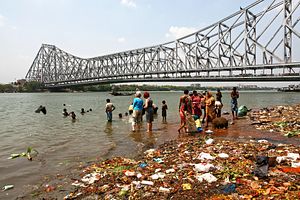India has replaced China as the country with the largest number of cities in the world’s top 20 most polluted (in terms of air quality). That announcement has prompted a number of articles comparing the two countries and suggesting that India should learn from China — from both its past mistakes and its path forward. Certainly, there are some obvious similarities. An article in the Khaleej Times notes a litany of Indian environmental challenges that could easily have been lifted from an article on China: tap water that is not potable, massive mounds of plastic in landfills, and a devastating problem with e-waste. India’s water scarcity challenge also has begun to sound like that of China: More than half of India’s population faces “high to extremely high” water stress. Moreover, corruption plagues the environmental protection system in both countries. And the two countries, along with the United States, rank as the top contributors to global climate change.
In response to their environmental challenges, China and India are also adopting many of the same measures. They are experimenting with tradable permits (in China for CO2 and in India for PM2.5), continuous air pollution monitoring and reporting from major cities and industries, the establishment of eco or smart cities, and higher fuel and vehicle emission standards, among many other initiatives.
Yet as compelling as the similarities between India and China may be, what is even more striking are the differences. First, the two countries are at significantly different stages of economic development: India’s per capita GDP is less than one quarter of China’s, so its economic development needs are greater than those of China. For India, the temptation may be greater to continue to sacrifice environmental protection to rapid economic growth, but the opportunities for an earlier course correction are also greater.
Second, and more important, is the difference in the two countries’ political systems. China is an authoritarian state and pursues a top-down approach to environmental protection, using the levers of political and economic control it possesses — state-owned enterprises, the Internet, and the Communist Party — to try to enforce its policies; the role of grassroots organization and public participation, as well as of the media, remain highly constrained. Beijing wants to address the people’s needs by reforming environmental policy, but it wants to control the nature, the pace, and the narrative of that reform.
India has no such ability — or perhaps even interest — to approach its environmental protection effort in this manner. A new book by India’s former Minister of State (Independent Charge) of Environment and Forests Jairam Ramesh, Green Signals: Ecology, Growth, and Democracy in India, underscores the point. The book details Ramesh’s experience as head of India’s environmental protection effort for the past several years. For Ramesh, India’s political system is a defining feature in determining the evolution of the country’s environmental protection effort. The fact that he could write such a book — which is a compilation of his letters and reports on interactions with NGOs, the prime minister, and other government and business actors — with the subtitle “Ecology, Growth and Democracy in India” is the first indication of the gap in approach between the two powers. Qu Geping, the first chief administrator of China’s National Environmental Protection Bureau, has also written books on the environment but not ones that reveal the contemporary dynamics of Chinese environmental policymaking.
Ramesh begins his book by discussing the fundamentals of environmental protection: transparency, making tough choices about how to balance and integrate environmental protection with economic growth, building a partnership with the judicial system, adopting market-based mechanisms such as cap and trade, and listening to civil society. Ramesh’s policy notes and letters highlight a number of cases in which civil society’s interests emerge as paramount. For example, in one letter he supports a women’s group that is concerned about a planned expansion of a zoo that would negatively affect a botanical garden; in a second, he highlights the important role of NGOs in a dramatic battle between coal mining interests and forest conservation proponents. Importantly, transparency is a given in India in a way that is still nascent in China. In India, one can learn the precise levels of soil toxicity and its sources in a given state. In China, one can only know the broad contours of soil contamination for the entire country.
“Does system type matter?” is an age old question in political science that also has profound implications for real-life policy debates over political models. To date, neither India nor China has emerged as a model for environmental protection that any other developing country would want to follow. The two countries push forward, each with a strong leader at the helm, and each with a new-found appreciation for the importance of environmental protection in preserving public health and future economic growth potential. They are likely to provide important insights into not only which policy mechanisms are most effective but also into how system type may both advance and inhibit effective environmental protection. In this way, India may indeed learn from China, but China may also learn something from India.
































